What is a plant
- What is a plant
- The most popular varieties of home beauties
- How do indoor gerberas grow
- How to create favorable conditions for a plant
- Watering and feeding
- Transplanting
- Possible diseases and pests
The legend says that a beautiful forest nymph Herba was surrounded by a crowd of fans, admiring her heavenly beauty. Such a close attention bored the prelest, and she wanted to turn into a flower. So on the ground appeared gerbera, combining aristocratic grace and maiden modesty. For a long time this plant - a symbol of innocence and beauty - decorated only open flower gardens and greenhouses of large cities. And later, thanks to the efforts of the Dutch breeder Robert Jameson, the gerbera room appeared - care of her at home is quite simple.
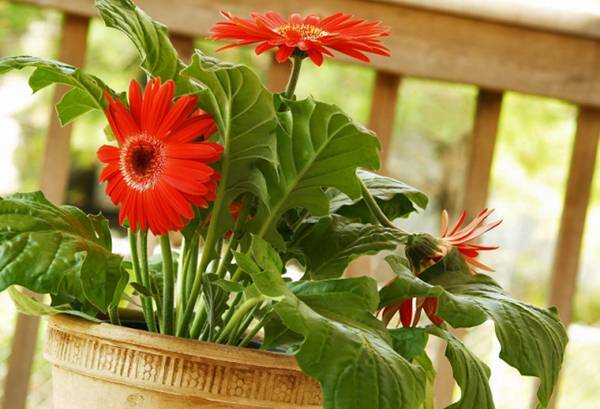
What is the plant
Homeland gerber - South Africa. It was here, on the high mountain meadows, that this exotic flower was first noticed. Probably, the bright African sun gave the gerbera such richness of colors and forms. Yellow, red, pink, orange, with small terry or large petals - these flowers have sunk in the soul of fans of plants around the globe.
To such an unearthly beauty came to every apartment or house, the breeders had to work hard. As a result, a new - room - a kind of gerberas, or mini-gerberas, belonging to the perennial grass of the family of Astrope or Complex, with the following characteristics.
- This is a perennial plant whose life cycle reaches 5 years.
- The height of the bush does not exceed 35 centimeters.
- Rhizome - long, with cord-like branches.
- The stem is thick and straight, it can be covered with thin light villi.
- Leaves - rather large, up to 15 centimeters, bright green, pointed or rounded, collected at the root of the rosette.
- Flowers - single, large, similar to chamomile.
- Color is presented in different shades, except blue.
Council
After 3-4 years of development, the intensity of flowering of the room gerbera will begin to decrease, as a result of which the bush is rejuvenated, dividing it into several parts, or replaced with a new plant.

The most popular varieties of home beauties
To date, there are more than 70 different varieties of room gerberas that can satisfy the requests of even the most sophisticated flower growers. The most popular is the Giemsona gerbera, due to its unpretentiousness, variety of shades and beauty. Her image can be seen even on the coat of arms and the flag of one of the South African provinces.
Based on the classification of varieties of this plant most often take the form of a flower. According to this feature, experts identify five main groups.
- Plants with small, up to 8 centimeters in diameter, flowers and narrow petals, similar to daisies. An example is the "Alcor" brand of dark red color and the pink "Aldebaran".
- Large-flowered with narrow petals - they are also called American type gerberas. Lovers of flowers are known for dark cherry inflorescences "Algol", yellow "Jupiter" and solar "Vega".Flowers in diameter reach 13 centimeters.
- Gerbera large-flowered with very wide petals - quite a large group, represented by red "Romeo", "Peter", "Alamak", yellow "Markal" or pink "Faith".
- Terry narrow-leaved flowers - "Viola", "Sonya" with red flowers or bright yellow "Kalinka".
- Terry flowers with wide petals - very popular is the maroon velvety "Spark".
These are only a few, the brightest representatives of miniature gerberas. On this list does not end, especially since every year new exquisite varieties are added.
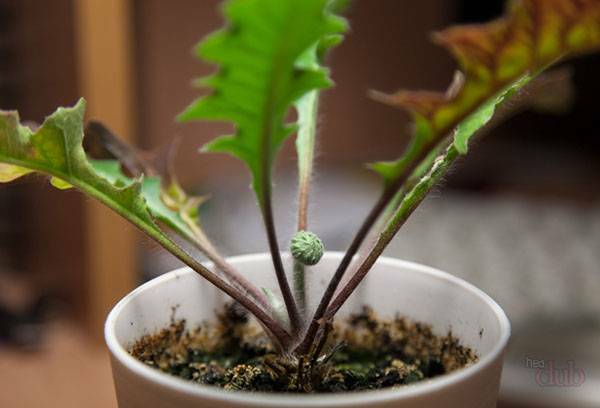
How to multiply indoor gerberas
How to grow a gerbera at home? Such a question is of interest to many amateur growers. When the bush becomes obsolete and the flowering stops, there is an opportunity to return the plant to life, dividing into shoots. For this:
- divide the bush in half - it's best to do it in the summer;
- slightly shorten the roots;
- remove flowers;
- on each process leave 2-3 points of growth.
Planting the sprouts in the pot should be done in such a way that the ground does not cover the point of growth. The roots will appear in about a month, and the newly emerged flower will be an exact copy of the old one.
Advice
Before planting in a pot all slices should be sprinkled with coal powder and earth.
You can also grow an exotic beauty by using cuttings:
- cut a piece of rhizome from the young bush so that 2 leaves remain;
- crop the leaves to 1/3;
- put in pots and cover with a film.
With proper care, new shoots should appear about a week after planting.
Tip
To ensure that the cuttings take root, water them abundantly, do not allow the primer to dry out. The air temperature in the room should be comfortable for growth - about 250 C.
The most laborious are planting and caring for the seeds of gerbera.
- First you need to prepare the seedling composition: mix in equal proportions sand, peat, perlite and leaf ground. In this case, a fluffy, friable mixture should turn out. A simpler variant is the growing of a plant in melange made from sand and peat.
- For disinfection, the prepared mixture is abundantly watered with a weak solution of potassium permanganate or frozen in the refrigerator.
- In the pot necessarily make a few holes, put a drainage layer of claydite on the bottom( about 3 centimeters), then fill up to the top with earth, compact and water abundantly.
- Seeds scatter on the surface, slightly sprinkled with sand;
- Put the seedlings in a warm place.
- After about a week, the first sprouts will appear, and then the leaves. Once this happens, it is necessary to dive the seedlings in a large container at a distance of 8 centimeters from each other.
- Once the seedlings grow and release 5-6 new leaves, they need to be seeded in separate containers. For this purpose, it is better to choose medium, diameter about 10 centimeters, pots.
Now you have to be patient and wait. By the end of the first year of growth, an exotic plant will certainly please you with flowers.
Advice
When purchasing seeds, be sure to pay attention to their expiry date. Seeds from the store keep germinating for six months, and collected at home - only three months.
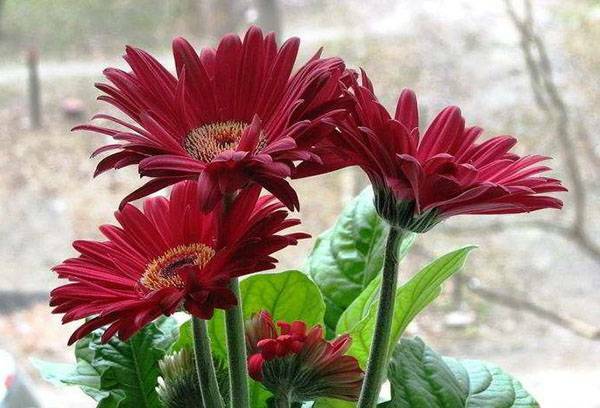
How to create favorable conditions for a plant
To an African beauty constantly pleased you with its flowering, first of all you need to organize a decent care for gerbera at home.
- Gerberas are very photophilous, but do not tolerate direct sunlight - they turn yellow leaves and burn flowers. The best option is the sill on the east or west side. The absence of a bright sun during the winter period completely replaces artificial lighting.
- The room should be warm - around 240 ° C. Sharp temperature changes are unacceptable, especially in the period when the flower is tied. In winter, when the air becomes cooler, gerberas stop flowering. At temperatures below 120 ° C, the plant may die. In cold weather it is recommended to put pots on the stand to avoid freezing of the roots.
- This indoor flower is very fond of fresh air. Therefore, on a summer day, it is worth putting it on a balcony or ventilating the room well. The main thing is to protect the gerbera from drafts.
Advice
Do not be discouraged if from June to August you will notice a break in the gerbera blossom. This is a short respite, due to the long duration of daylight hours. Flower buds in this period are not laid, but the leaf mass is growing. After a little rest, the plant will please you with a riot of flowers.
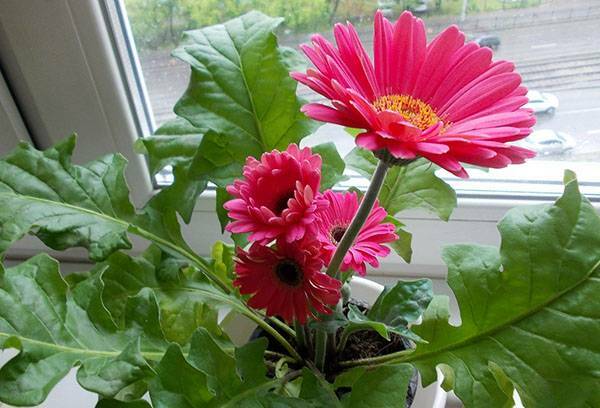
Watering and top dressing
In general, care for the gerbera is quite simple. But the knowledge of the basic irrigation rules will not be superfluous for amateur gardeners.
- Gerberas love water, but in moderation. Overabundance of moisture can cause decay of roots and the appearance of fungus, and the disadvantage is the formation of a dry root coma. The plant requires uniform irrigation at any time of the year.
- Water for irrigation is better to use unboiled, stationary, room temperature. Too cold water harms the plant.
- When watering the water should not fall into the center of the root outlet - this can provoke rotting of the base of the stem. Therefore, it should be poured neatly on the edge of the pot, or, even better, in the pan. In this case, excess water in 30 minutes must necessarily be drained.
Advice The Miss Cleaner Magazine draws your attention to the fact that Gerbera leaves need frequent spraying. It is important that water from the spray does not fall on the flower. Drops exposed to direct sunlight cause burns on petals and leaves.
With regard to fertilizing the plant, there are also subtleties here.
- It is important to know that for gerberries you can not use organic fertilizers - humus or compost can spoil the roots.
- The best mineral fertilizers with high potassium content are suitable for these pot plants.
- During the rest period, it is best to use nitrogenous fertilizers.
- Young plants require a fairly frequent feeding - 2-3 times a month, for adult plants enough 1-2 times a year.
- A solution for top dressing should be prepared strictly in accordance with the instructions for fertilization. It should not be too concentrated to not damage the roots of gerbera.
Nutrients stimulate plant growth, maintain its flowering and protect against pests.
Advice
Excessive application of fertilizers during flowering leads to falling colors!
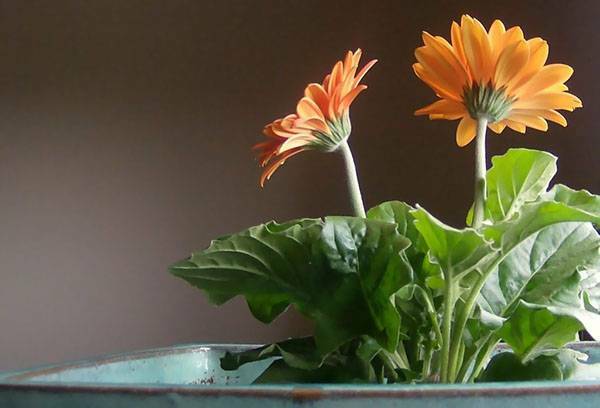
Transplant
Do not rush to replant the plant you just bought. It should stand in your apartment for at least two weeks to get used to new environmental conditions( temperature, humidity, illumination) and get out of the stressful state.
If the gerbera blooms - wait until the end of this period. Now boldly proceed to the transplant.
- The pot should be only a few centimeters wider than the former, not too deep, to avoid excessive overgrowth of the root system. Ideally gerbera feels in clay pots - they are porous, easily pass air, enriching the earth and roots with oxygen.
- Fill the tank with a nutrient mixture of 2 parts of the earth, 1 part of peat, 1 part of sand with the addition of pine bark.
- Remove old, so-called "transportation" ground carefully from the roots of the plant, shaking or rinsing them. Now you can put the gerbera in a new pot.
Council
If the transplanted plant is sick and can not adapt to the new conditions, it is worthwhile for a while to create conditions for it that are close to the greenhouse. For this it is enough to cover the hive with a plastic bag, periodically opening it for airing.
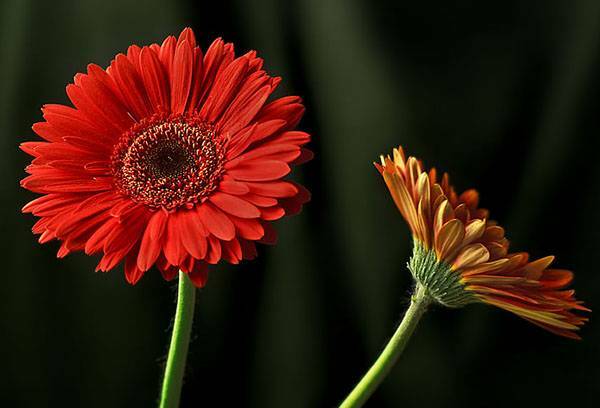
Possible diseases and pests of
Breeders, working on the creation of a room variety of gerbera, selected the most persistent and viable varieties. Nevertheless, newly-derived species of potted flowers are susceptible to many diseases and pests, the most common of which are the following.
- Gray rot - the pathogen is a special mushroom that infects the leaves and flowers, covering them with a thick gray coating. The reason for the reproduction of fungi is excessive moistening of the soil or watering with cold water. To get rid of them it is possible by excision of the amazed sites, processing by their charcoal and transplantation of a plant.
- Cucumber mosaic - deforms and spoils gerbera leaves: they appear ugly spots and veins. The disease is caused by a virus that carries insects from pumpkin plants. The disease is not too dangerous, since it does not harm the root system. In the fight against it will help insecticides and simple washing of stems and leaves with warm water.
- Powdery mildew is a white coating formed on the leaves and buds of young gerberas. The reasons are an excess of moisture, a high air temperature and an excess of nitrogenous fertilizers in the soil. Fighting the disease with special substances - fungicides, stopping the development of fungi.
- Sclerotoniosis is another fungal disease affecting the gerbera. Its characteristic feature is large relief spots, which are then covered with a touch of white color. The causes of the appearance of the fungus are the same: soil overmoistening, oversaturation with nitrogenous fertilizers, lack of ventilation.
- Alternaria - yellowed or covered with dark red spots with velvety coating leaves indicate that the plant is weakened due to a lack of nutrients.
- Phytophthorosis - begins with the drying of the leaves, then the process spreads to the roots. Without proper treatment, the plant will die. Therefore, at the first signs of late blight it is necessary to replace moist soil in a pot on a dry soil and treat the bush with fungicides.
Threatened by gerbera and pests. It is easy to see and distinguish them.
- Spider mite - entangles individual parts of the plant with a web. Insecticide treatment and washing with warm water will relieve the gerbera of suffering.
- A small whiteflyfly butterfly lays white larvae that suck the plant juice. As a result, the leaves turn yellow and dry. It is rather difficult to get rid of such pests - the gerbera should be isolated from other indoor plants, rinsed with warm water and household soap, and watered every 3 days with a special preparation "Permethrin".
Careful and attentive to the bright African beauty, and she will delight you for a long time with a delightful bloom.
Read the article about what flowers to put on the balcony
